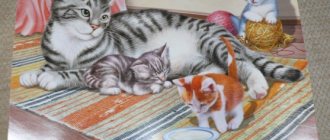Goals
Lexical work: introduce children to the use of words in a figurative meaning.
Formation of the grammatical structure of speech: develop children’s ability to construct phrases with a given word.
Nurturing the sound culture of speech: develop children’s ability to identify sounds at the beginning, middle and end of a word; the ability to lay out the sound pattern of a word.
Development of coherent speech: develop children’s ability to compose a story from a picture using a plan.
Development of social skills: development of the ability to work in a team, negotiate and cooperate with each other.
Lesson materials
♦ Family photographs of children brought from home, in which they and their relatives are depicted against a background of flowers and a spring landscape.
♦ Small format cards (7x7 cm) with images of meadow, wild, forest and garden flowers - according to the number of children.
♦ Pictures in A5 or A4 format with images of flowers.
♦ Circles of red, blue and green for creating a sound diagram of a word - for each child, and one set of a larger size - for working on a flannelgraph or magnetic board.
Progress of the lesson
Part 1
Introduction. Breaking down into teams using the game “Find Your Group”
The teacher invites the children to come to the table and choose one of the cards laid out face down on the table. The cards depict flowers and herbaceous plants, and their selection should be approximately the same: 5 forest (lily of the valley, bellflower, nettle, snowdrop, hops), 5-6 meadow (chamomile, dandelion, St. John's wort, buttercup, clover, fireweed), 5 field (cornflower, wheatgrass, field poppy, plantain, chicory), 5 garden ones (aster, gladiolus, tulip, rose, carnation). Children are asked to look carefully at their pictures and break into four subgroups. The principle of division is not specified; children are given independence. After the teams are created, the teacher asks the children of each of them to explain why they teamed up.
Part 2
Education of sound culture of speech. Isolating sounds in a word. Drawing up a word diagram
Educator:
— You have turned out to be “flower” teams. Today they are offered different tasks.
The first task is related to the names of your flowers. I place pictures of these colors on our magnetic board. Your task is to find among the names of flowers and herbs those whose names contain sounds:
“s” - snowdrop, aster, gladiolus; “s” - cornflower;
“r” - nettle, chamomile, plantain, St. John’s wort, clover, aster, rose;
“ry” - chicory, wheatgrass, fireweed;
“l” - bell, lily of the valley, gladiolus;
“l” - bell, buttercup, hop, cornflower, tulip.
In addition to naming the word, children must indicate where (at the beginning, middle or end) the indicated sound is located. Each correct answer is marked with a token.
Educator:
- Well done, you did a great job with this task. And now the work awaits you on drawing up the sound diagram of the word. The wildflower team makes a diagram of the word “cornflower” - each in its place, and Misha - on the board; the meadow flowers team makes a diagram of the word “buttercup” - each at their own workplace, and Sveta - on the board; the forest flowers team will draw up a diagram of the word “lily of the valley”, I invite Dima to the board; the garden flower team is drawing up a diagram of the word “tulip” - Masha will do it on the board.
When drawing up a word diagram, children use red chips to indicate vowel sounds, blue chips for hard consonants, and green chips for soft consonants.
Each scheme is disassembled and checked by all children together. Correctly completed tasks are marked with chips.
Part 3 Vocabulary work
Educator:
- Well done, now let's remember why flowers bloom in the spring, why all nature awakens in the spring? That's right, because in spring more sunlight hits the ground. We also say “warm sunshine”. What does this expression mean? That it became warmer outside.
What else can you say “warm” about? Warm day, warm fur coat, warm scarf, etc. They also say “warm relations”. What does this phrase mean? Listen to the poem:
“I miss warmth,” the mother said to her daughter.
She was surprised:
- You're freezing
And on summer days?
What kind of warmth do you think the girl’s mother was talking about? That's right, she meant warmth. Did the girl understand her? No, probably the daughter did not have warmth towards her mother. I am sure that you love your parents and treat them with warmth.
Therefore, I asked you today to bring your family photographs, where you and your parents - dad or mom - were photographed against the backdrop of a spring landscape and flowers. Now I ask you to tell me about your photographs.
Part 4 Creative storytelling using photographs
The teacher asks the children to compose a story following the plan:
• When was this photo taken?
• Where was it made? Describe the area shown in the photograph.
• Who is in the photo?
• Describe your parents' appearance and their character traits.
• Remember what happened when the photo was taken.
• Tell us about what is happening outside of this photograph: who is photographing you, who else was with you in this place, how did you spend your time?
When composing stories, the teacher encourages children to use figurative expressions, comparisons, and asks them to remember the sensations and feelings that they experienced at the moment when the photograph was taken. The most interesting stories are marked with chips. If possible, make audio recordings of children’s stories or write them down by hand, and then let parents listen or read them.
After listening to the stories, the teacher asks the children to summarize the lesson, count the chips they earned and evaluate their work and the work of their team.

